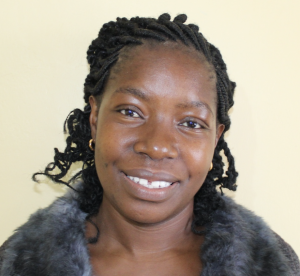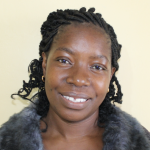The 188 students and staff of Namatala Girls Secondary School struggle to access safe, sufficient water. Though they have a few different water sources at their disposal, they all have unique challenges that steal time from their education and, as a result, adversely affect their futures.
Field Officer Christine Masinde shared how this school is affected by the water crisis. "Currently, the school depends on a protected hand-dug well with [a] cover which is on the school compound, but it goes dry during dry seasons, and sometimes [the] water is exhausted from the well when the water need is high in school."

"The [well] hole has a cover, but when [it's] open, it poses [a] danger to pupils and staff who use it daily. When the well is dry, students are forced to go and fetch water from a nearby protected spring. The spring is shared with other community members, which creates congestion in the spring, and so much time is wasted there. The path to the spring is steep, and when it rains, it becomes slippery and causes falls that lead to injuries to the students," she continued.

The Namatala Girls Secondary School started in 2016 with only four students. It has grown exponentially; however, a lack of available water stunts growth. Teacher Tom Ochieng (shown below), 36, shares how this hardship has affected the school.

"Lack of a reliable water point in our school has contributed to the low enrollment of new students. Some who join the school leave after a while to join other [more] well-equipped schools. As a teacher, it pains [me] to lose [our] best students to neighboring schools, yet we have the capability of performing better if only we could access a reliable water point and improved school facilities."
When the hand-dug well isn't dry, the water it provides is often contaminated. Field Officer Christine said, "For the hand-dug well in as much as it has a cover, the jerrican and rope used to draw water easily transmits dirt to the groundwater and contaminates it. When it rains, dirty water drips inside the well too."
"Students and staff drink water directly from the water source without any treatment. This has given rise to the spread of waterborne illnesses like H-pylori (a bacterial infection), typhoid, diarrhea, and bilharzia. As a result, absenteeism is common among students and staff as well. Medical bills are also high. Overall academic performance of the school deteriorates day by day," Christine continued.
Water is essential to the functioning of any school. Students and staff are burdened without reliable, easy access to safe water. Time wasted seeking water takes away from energy and classroom time. Even coming to school is a hardship if a student's basic needs aren't met.
16-year-old Everlyne M. (shown below) shared, "This is a girl's school which [means we] need to have a reliable source of water in the school compound, yet sometimes we lack water in school. During my menstrual periods, if there is no water in school, I stay at home. I hope our bathrooms will be installed with water one day so that we can maintain hygiene during our [periods]. Our laboratories also need sufficient water so that we can compete confidently with our peers from other schools."

A new borehole well will help solve the challenges the students and staff are facing at Namatala Girls Secondary School. Borehole wells are drilled much deeper than hand-dug wells, eliminating the issues they face during the dry season. They have pumps, so the chances of contamination are much lower.
Safe, reliable access to water on school grounds will give students like Everlyne a chance to reclaim their time and future. Teachers like Tom will have the opportunity to reach more students as they will have adequate facilities to hopefully achieve their dreams of turning this into a boarding school.
Water at schools is unique, which is why we need unique solutions.
The Proposed Solution, Determined Together...
At The Water Project, everyone has a part in conversations and solutions. We operate in transparency, believing it benefits everyone. We expect reliability from one another as well as our water solutions. Everyone involved makes this possible through hard work and dedication.
In a joint discovery process, community members determine their most advantageous water solution alongside our technical experts. Read more specifics about this solution on the What We're Building tab of this project page. Then, community members lend their support by collecting needed construction materials (sometimes for months ahead of time!), providing labor alongside our artisans, sheltering and feeding the builders, and supplying additional resources.
Water Access for Everyone
This water project is one piece in a large puzzle. In Kenya, Sierra Leone, and Uganda, we're working toward complete coverage of reliable, maintained water sources that guarantee public access now and in the future within a 30-minute round trip for each community, household, school, and health center. One day, we hope to report that this has been achieved!
Training on Health, Hygiene & More
With the community's input, we've identified topics where training will increase positive health outcomes at personal, household, and community levels. We'll coordinate with them to find the best training date. Some examples of what we train communities on are:
- Improved hygiene, health, and sanitation habits
- Safe water handling, storage & treatment
- Disease prevention and proper handwashing
- Income-generation
- Community leadership, governance, & election of a water committee
- Operation and maintenance of the water point
Handwashing Stations
Alongside each water source, we also provide two new gravity-fed handwashing stations that will allow everyone at the school to wash their hands without running water. Handwashing is so important to help prevent future water-related illnesses in the school community.
The student health club will maintain the stations, fill them with water, and supply them with soap (which we will teach the school community how to make during the training!).
VIP Latrines
In addition, we will construct two triple-door Ventilated Improved Pit (VIP) latrine blocks designed to prevent fecal disease transmission. Each latrine will have a cement floor, which is easy to use and clean regularly. Three doors will serve the girls, and three doors will serve the boys.



 Rehabilitation Project
Rehabilitation Project


































